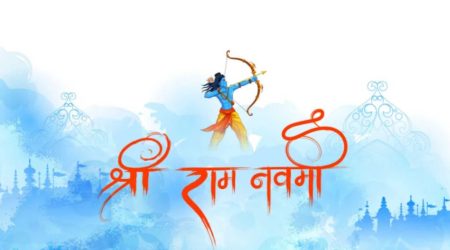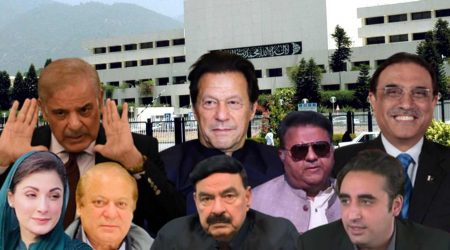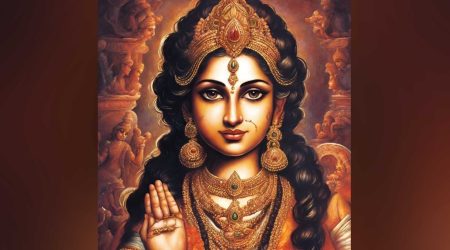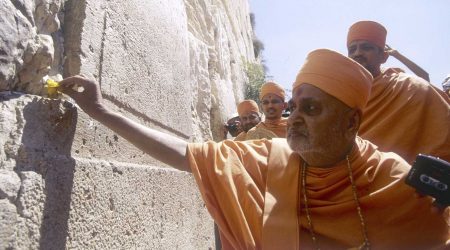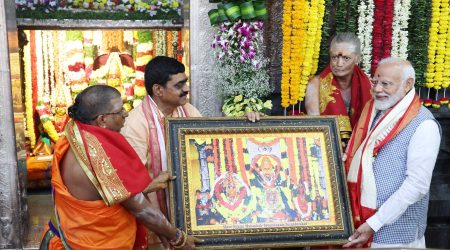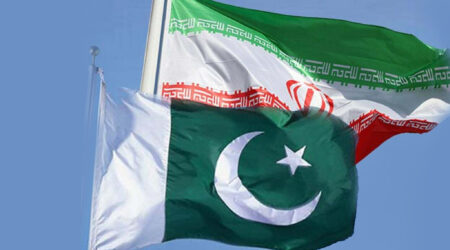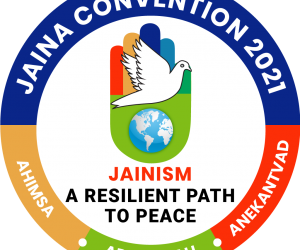By Dr. Lakshmi Bandlamudi
Ramuni Maravaka Ve Manasa!
Oh! Heart, Do not forget Ram!
– Saint Tyagaraja
My beloved Avva (Paternal Grandmother) – a devout Ram Bhakt instructed me when I was heading to the USA – Ramuni Maravaka Ve, meaning Do not forget Ram.
She added, ‘take good care of Ram’ – this idol (in picture) has been handed down in my family history for over seven generations. It must be noted that she didn’t say ‘Ram will take care of you,’ instead, she extracted a promise from me – ‘Take good care of Ram’ – because when you do that everything falls in place.
Thus, the Murti resides in my home in New York, and I do my humble part, remembering the tales that my Avva told me about the wonder called Shri Ram.
This two syllabled name Ram is indeed magical. Ram-Ram, is a way people greet in many parts of India, at moments of exhilaration we shout Rama, Rama; when in pain the utterance that comes at ease is Hey Ram and when in shock, or disgust or accident, one says, Ayyo Rama or Che… Che… Rama… Rama… and so on. Ram is so easy on Jihva – tongue – short, sweet, and effective that it becomes the heartbeat of consciousness and that of a civilization.
That is why the Pran Pratishta of Ram Lalla on January 22, 2024, held in Ayodhya is a momentous occasion and its significance goes way beyond India. In space, it revives all the regions, where Ramayana culture spread and in time it is a beautiful and meaningful excursion into the past – the Treta Yuga to find the relevance of that time period to our present Kali Yuga.
There is something unique about Rama Bhakti. Prabhu Sri Ram embodies Karuna Rasa – Compassion. I have never seen my Avva cry to Ram and communicate her grievances and challenges, instead she would weep for the adversities faced by the God she loved and worshipped.
About her challenges, the answer was simple; having taken the Nar (human) Avatar, even Rama was not spared of pain and suffering, and therefore it was only natural that any mortal being is bound to experience innumerable challenges, when thrown into the Samsara Sagaram – the ocean of earthly life.
Rama not only embodies compassion, but also generates that emotion in his devotees. From Tyagaraja to Bhadrachala Ramdas to Tulsidas to Kabir and Guru Nanak, all have conveyed emotions so tender and so everlasting in their compositions that they instantly soften our heart and soul.
The activities in a day or moments during a significant event can be covered through the compositions of these great mystics. Start the day with Tyagaraja’s Meluko Dayanidhi, Meluko Dasarathi to wake up Ram.
To describe his baby steps, sing Tulsidas’s Thumak Chalat Ramachandra…; when you are wonderstruck by the beauty of Rama and fall short of words, think about Tyagaraja’s Entha Muddo, Entha Sogaso, Everi Valla Varnimpa Tagune… how endearing and how enchanting, who is capable of describing this…; When you want to feel the power of Ram Nam listen to the composition of Sant Khalas, a Muslim poet, Khalas ek Bhagwan Bharose, Sumiran Kar Man Saanjh Savere, Ram Nam Jap Leejo Prani… the God that Khalas trusts, Remember, O’ Mind, evening and morning, take on the Ram Nam Jaap, O’ living being…nothing can be more reassuring than these lines.
When Rama marries Sita, sing Sita Kalyana Vaibhogame and when the newlyweds are on a swing, sing Uyyalalugavayya… while I rock, swing O’ Rama…; and when you need to put Ram to sleep, sing softly and gently the lullaby, Ananda Ghana Rama, Jo…Jo…..
With such abundance of compositions by Ram Bhaktas, every mood, emotion, and mode of relating to Ram can be found in our endless civilizational history.
Avva’s tales and the tales of Bhadrachalam
In my growing years, Sri Rama Navami was celebrated with great pomp and excitement. My beloved Avva never got tired of repeating an ancestral story. She would say, with her eyes wide open, “this Ramachandra Murti has been worshipped in our lineage for more than seven generations,” and up to this point, the tale was readily accepted, and then she would continue, “During the Ram Navami celebrations that always happens on hot summer days, a thirsty Nawab stopped in front of the house of one of our ancestors, and the elderly woman of the household offered him the Prasad – Paanakam (jaggery water), Neeru Majjiga (watery seasoned buttermilk) and Vada Pappu (moong dal salad).”

Avva would continue, “The Nawab, having quenched his thirst and satisfied, gave the family a small pouch of pearls for the Talambralu (a wedding custom where the bride and groom pour dry rice over each other’s heads) in Sita Kalyanam.” With enormous pride, Avva would tell the gathering, that even a Nawab was enamored by this Ramachandra Murti and gifted precious pearls. Noticing disbelief or skepticism on the face of listeners, she would say.
“Ramudu Sakshi, this is what my elders told me, and they heard the same story from their elders.” Once you invoke Ram as witness to the tale she heard, no one could or would question the veracity of the event. As for me, I didn’t want to displease her, fearing that my bedtime stories would be discontinued. Besides, Avva might embellish a story, but not tell a false story. Her narrative pull was so strong, one readily surrendered.
Now, let us come to the story of Bhadrachalam.
A major Ram Mandir before the Ayodhya temple is inaugurated, perhaps has been in Bhadrachalam, Telangana – on the banks of Godavari – on a hill. Before becoming a major shrine, the Murtis were in a modest structure and it was Kancharla Gopanna, who later came to be called as Bhakta Ramdas built this magnificent temple.
Gopanna was a Tashildar in the court of Nawab Abul Hussan Tanishah, the ruler of Golconda. Gopanna used the money from land revenue to build the temple and make jewelry for all the deities, without the permission of Nawab, hoping to collect money from donors in future to repay what he has taken from the kingdom’s treasury. Gopanna sincerely believed that Lord Rama deserved a temple in his district and saw nothing wrong in using state funds and he was happily composing and singing songs on Lord Rama and from then onwards he came to be known as Bhadrachala Ramdas. When Nawab Tanishah came to know about it, Ramdas was duly imprisoned and tortured for 12 long years from 1665 to 1677.
During these years of imprisonment, Bhakta Ramdas spontaneously composed and sang some of his finest and most poignant pieces and they reveal his pious nature, a childlike innocence and intense love, devotion, and freedom he felt with Lord Rama. In one of his prominent compositions, he pleads and begs Rama to take pity on him,
Ikshvaku Kula Tilaka, Eka Naina Palukave, Ramachandra,
Nannu Rakshimpakunnanu Rakshakulevaraiyya Ramachandra.
Oh! The Jewel of Ikshvaku dynasty, say something at least now,
If you don’t protect me, who else can be my protector, Ramachandra?
In each stanza in this song, Ramdas gives a detailed account of money spent on various aspects of the temple – building ramparts around the temple and constructing the Gopurams (towers) and then goes on to list the jewelry he made for every member of the Ram Parivar – emerald medallion for Bharata, gold waistband for Shatrughna, a pearl medallion for Lakshmana, emerald pendant for Sitamma, gold chains for the Vahanas (vehicles) and the last item on his expense list is glittering plume for Rama.
At this point in the song, Ramdas displays his ire and tells and asks Rama, “you seem to swagger along with pride flaunting the jewelry I made for you as if it is your ancestral property. Did your father Dasharatha present the ornaments to you or did your father-in-law, Maharaj Janaka send them to you?” In the very next stanza, the tone becomes regretful and apologetic, “do not be exasperated that I scolded you Ramachandra, unable to bear the pain from the lynching, I am blaming you.” Ramdas goes on to plead Rama to clear his debts and then govern the town of Bhadrachalam. Emotions reach their peak in this song, from despondency to matter-of-fact accounting of expenses to wrath, followed by contrition and explanation and finally praise the glorious and compassionate nature of Sri Rama.
It is said that after 12 years of imprisonment of Ramdas, Nawab Tanishah heard a knock at his door late at night and when the doors were opened, two young men introduced themselves as Ramoji and Lakshmoji and showed a bag of gold coins to the Nawab and said they came to settle the expenses incurred by Ramdas. Tanishah accepted the coins and affixed his seal stating that the debt was cleared. Two of these coins are on display along with all the jewels that Ramdas made in the Bhadrachalam temple museum. Later, the Nawab not only freed Ramdas, but also gave additional funds to complete the construction of the temple. Ironically, on learning that Tanishah treated the Hindus well, the Golconda empire was attacked by Aurangzeb and Tanishah was captured and died in prison many years later and his ministers were slaughtered.
Now returning to my Avva’s tale about – a Nawab presenting my ancestor with a pouch of pearls after quenching his thirst – was neither accepted nor rejected in my mind, but when I visited the Bhadrachalam temple, I was forced to ponder and re-examine my impression. In the history of the temple, I read that Nawab Tanishah used to send a bag of precious pearls for the Talambralu ritual during the Sita Kalyanam ceremony on Rama Navami Day and the priest/storyteller in the temple during a Puja narrated the same story. The temple also added that the descendants of the Nawab continue to send pearls for the occasion to this day.
I was completely dumbstruck by the identical tale that my Avva told us innumerable times. Did Avva or her elders somewhere in the lineage, pluck the story from the temple history and insert into their family tale? Was it a case of appropriation? Or was it simply coincidental? For sure, the Ram Vigraham in my household does resemble the Ramachandra of Bhadrachalam and perhaps my ancestors did live in that region of Golconda and genuinely had the experience of receiving pearls from a Nawab. One can only speculate on this family tale. I must confess however that I find deeper meaning in these parallel tales.
It seems to me that when the tale of a family and a shrine intersect, meaningful exchanges appear to take place. Nothing is compartmentalized anymore. The All-Pervasive Transcendental God becomes my personal God. In the Puja corner where my God resides (see picture below) gives structure and purpose in my daily life, and the God that resides in a temple is the collective God, meant for all.
Bhadrachalam and Ayodhya: A Checkered Past
If Bhadrachalam temple was built by the efforts of Ramdas and consequently suffered imprisonment and torture and through divine intervention survived, countless number of Ramdas – servitors of Ram – struggled and fought for over 500 years to guard, reclaim and rebuild a temple at the birthplace of Sri Rama.
The story of these temples is the story of Bharat, and these temples carry the imprint of cultural history in all its brutality and glory. The presiding deity in these temples – Sri Ram – is the very soul of an ancient and majestic civilization that continues to stand tall despite relentless and brutal attacks. The inauguration of Ayodhya Mandir on Jan 22, 2024 is indeed a momentous occasion. The world will once again hear the heartbeat of a Great Civilization…
Dr. Lakshmi Bandlamudi is a Professor at City University of New York. Email: [email protected]



